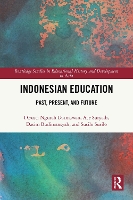


|
|
|
books
| book details |
Indonesian Education: Past, Present, and Future
By (author) I Gusti Ngurah Darmawan, By (author) Ace Suryadi, By (author) Dasim Budimansyah, By (author) Susilo Susilo

|
This book is currently unavailable. Enquire to check if we can source a used copy
|
| book description |
Offering an overview of the history, perspectives, and developments of education in Indonesia since the country’s independence in 1945, in this book, the authors raise awareness of education's impact on national development in this unique context. With more than 50 million students, 3 million teachers, and 300,000 schools, Indonesia's most significant challenge for education is not only to improve access but also to improve the education quality to face the fast-paced world we live in today. The book traces the development of Indonesian education since 1945, highlighting its successes, failures, and responses to social, political, and economic changes. It addresses key issues such as legislation, school systems, education management, national policies, quality versus expansion, equity, curriculum, assessment, and unemployment. This book offers a nuanced understanding of the history of education in Indonesia and serves as a comparative reference for studies with other countries. The book will be a valuable resource for researchers, students, and scholars of comparative education, educational history, and Asian studies.
| product details |
Normally shipped |
Publisher | Taylor & Francis Ltd
Published date | 29 Nov 2024
Language |
Format | Digital (delivered electronically)
Pages | 258
Dimensions | 0 x 0 x 0mm (L x W x H)
Weight | 0g
ISBN | 978-1-0402-5939-9
Readership Age |
BISAC | education / philosophy & social aspects
| other options |
|
|
|
To view the items in your trolley please sign in.
| sign in |
|
|
|
| specials |
|
|
|
Look around you is anything real or normal any more? News, images and videos created by AI are everywhere.
|
This first comprehensive biography of Cecil Rhodes in a generation illuminates Rhodes’s vision for the expansion of imperialism in southern Africa, connecting politics and industry to internal development, and examines how this fueled a lasting, white-dominated colonial society.
|
|
|
|